Margaret “Peggy” Bedford Bancroft d’Arenberg D’Uzes
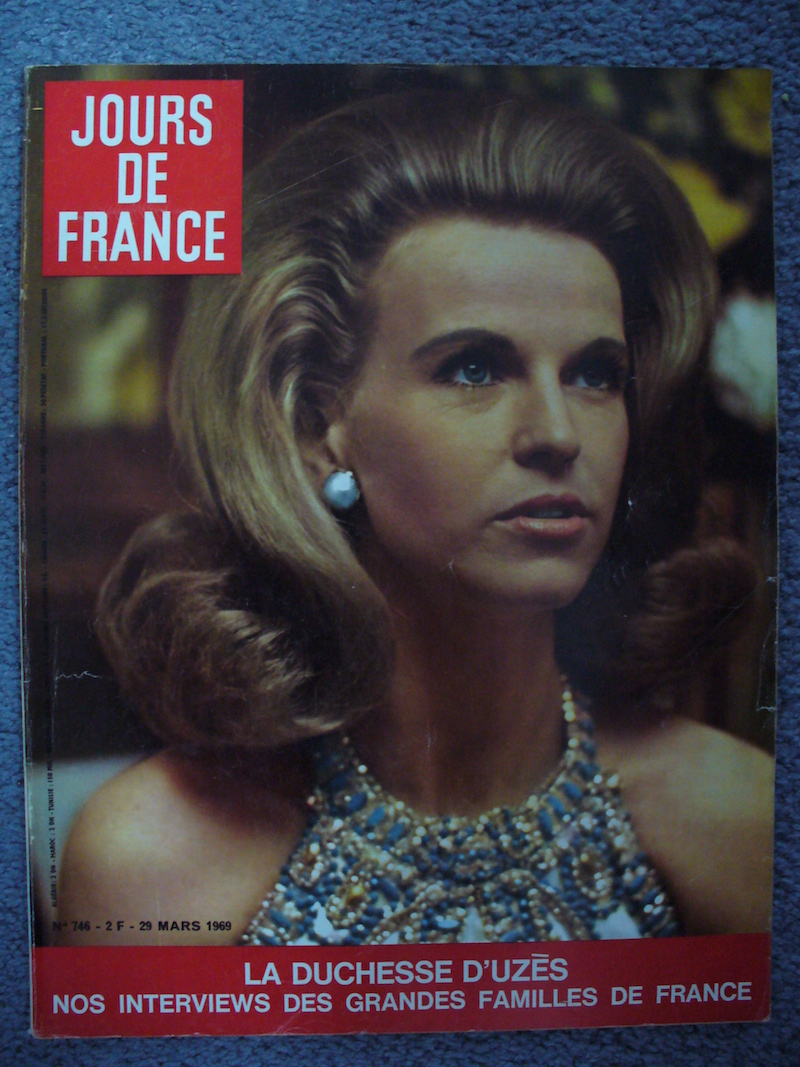
The outrageous antics, lavish lifestyles and love affairs of young heiresses, “it” girls of the moment and beautiful rich women who otherwise generally lived unremarkable lives have long held a strange fascination over the general public. Each generation produces a few that rise above their peers, becoming household names while others fade into obscurity. Brenda Frazier, Babe Paley, Sunny von Bulow, Princess Stephanie and Christina Onassis belong to an iconic roll call of names representing wealth, privilege, style, scandal or tragedy. One would think Margaret Bedford Bancroft d’Arenberg D’Uzes, a stunning heiress who filled the international headlines for over two decades, lived a life few could dream of but many envied, and pushed the boundaries of acceptable behavior, would also have a place within the aforementioned pantheon, yet she is curiously unrecognized today.Peggy gracing the cover of a French Magazine in 1968
Born in 1932 to Mr. and Mrs. Frederick Henry Bedford Jr., “Peggy” as she was nicknamed, began life ordinarily enough (when “ordinary” is qualified by your father happening to be one of the Directors of a little company called Standard Oil). The Bedford’s shuttled between their estate in Greens Farms Connecticut and a New York apartment in the Pierre Hotel. Young Peggy attended Chapin and Miss Porters, two schools that could boast some of the highest debutante rates, if not graduation rates in the nation. The vivacious, pretty blond didn’t excel academically, but she stood out amongst her fellow students. People were drawn to her warm, outgoing personality, even though observant ones could something restless in her luminous violet eyes. She followed all of the expected rituals of a young woman of her station, coming out in June of 1950 with a private dance at the exclusive Creek Club in Locust Valley, then made her collective bows at the Junior Assemblies and Junior League balls later that year. Dubbed one of the “debs of the season” by the press, less than a year later, she married handsome Princeton Senior and amateur tennis champion Thomas Moore Bancroft, Jr on April 15th 1951. Tommy, a grandson of Elsie Woodward, one of New York’s current reigning grande dames, possessed sterling social credentials. The ceremony at St James Church, followed by a reception in the ballroom of the Colony Club, was proclaimed the social event of the season by the press, uniting two of New York’s higher profile blue blood clans. Everything pointed towards Peggy’s having a very glamorous, albeit predictable future; membership in the right clubs, the Junior league, children and a comfortable berth in the upper strata of New York Society.
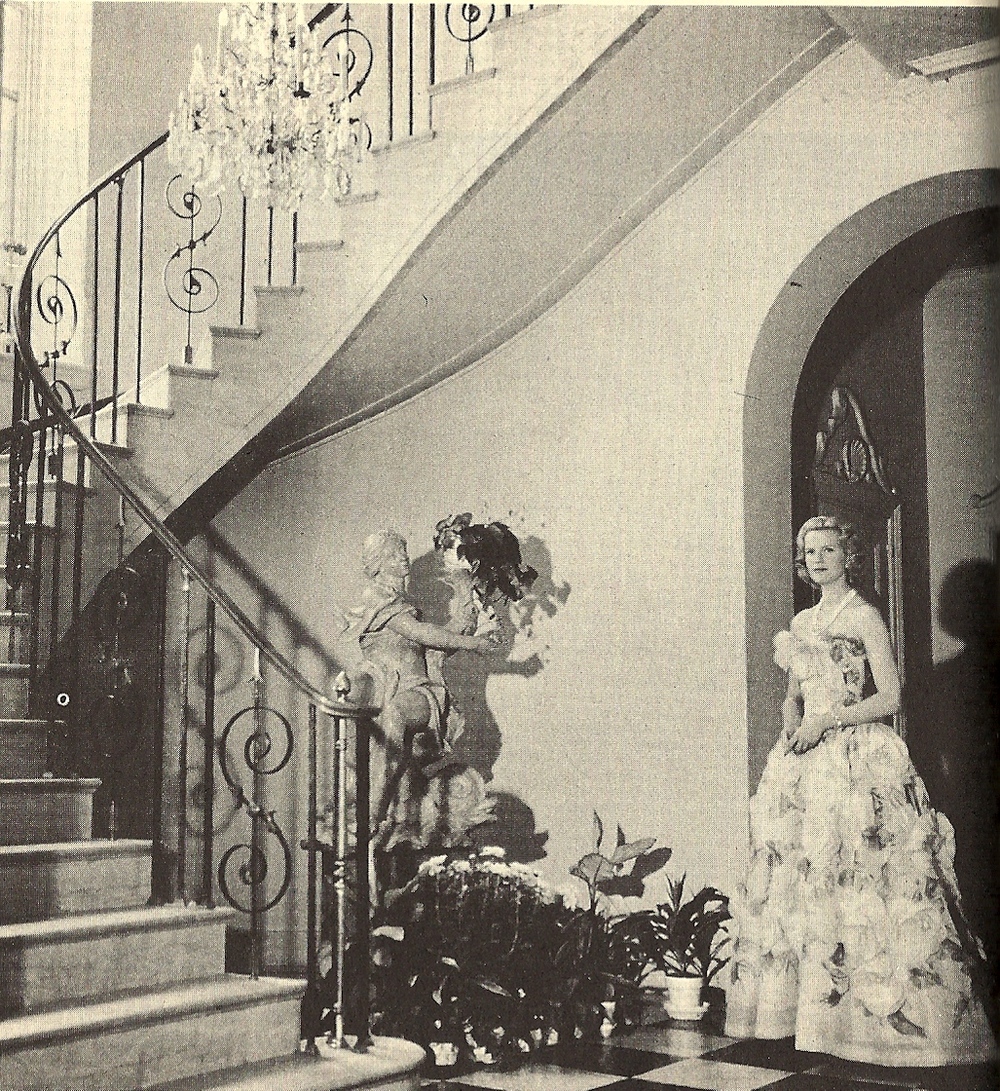
Tommy enlisted in the Navy after graduation, and the golden couple moved out west to Santa Barbara where he was stationed. A daughter named Muffie was soon born. On the surface Peggy settled into the role of dutiful wife and mother, yet her restlessness was soon evident. Whenever Tommy was on duty away at sea, Peggy immediately packed up Muffie and flew to New York, staying at her mother’s apartment at the Pierre (her father had passed away in 1952). When Tommy’s stint in the Navy was up, he joined his father’s textile firm and moved his young family back east. They initially lived at the Bancroft family estate in Old Westbury while Peggy began to search for an apartment in New York City. She quickly found the perfect starter apartment for her family. Tommy was horrified. Peggy had chosen a sprawling duplex on the 15th and 16th floors of 740 Park Avenue, then and now, one of the richest and most social co-ops in the city. Although no stranger to grand homes and lavish entertaining (his grandmother owned the famous Woodward mansion on East 86th Street at and his Uncle William Woodward’s “playhouse” at Sunken Orchard on Long Island was legendary, he was only 25 years old, and Peggy was still shy of 23. He argued they were too young to have such a large, expensive place and furthermore he had no desire to play the role of delirious socialite, preferring a quieter life. Whether bolstered by the recent inheritance of a trust from her grandfather’s estate (estimated to be between 3 and 5 million dollars), or influenced by her family friend, John D Rockefeller Jr who also lived in the building, Peggy insisted and got her way.Peggy in the foyer of her apartment at 740 Park Avenue
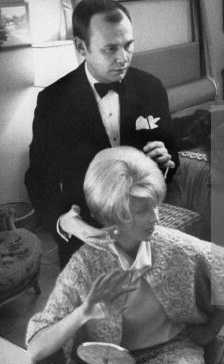
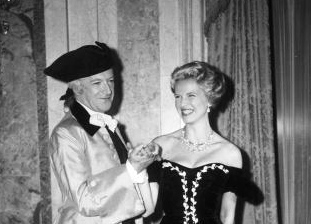
Eleven days after they closed on the apartment, Tommy’s Uncle William was shot dead by his wife Anne in a darkened hallway of the playhouse at Sunken Orchard. Claiming she she mistook him for a prowler, charges were never filed, and the incident became one of the scandals of the decade. This served to reinforce Tommy’s desire for a low-key, unassuming life, and true to his fears, Peggy used their new apartment to entertain often, and grandly. Peggy mixed blue bloods from the social register with celebrities from Hollywood and Broadway, throwing in titled Europeans for good measure. Never stuffy and always fun, invitations to her soirees became the most sought after in New York. In short order, Mrs. Thomas Bancroft Jr. was the reigning hostess of the younger social set, her only real competition coming from Mrs. Winston FC (better known as CZ) Guest. Named to the international best dressed list 3 times, Life Magazine even chronicled her having her hair done at the apartment by Kenneth, the celebrity coiffeur du jour. When the party wasn’t happening at her place, she went out and found it, more often that not without her husband (though she was always properly chaperoned).Peggy with Noel Coward at a Costume ball in the 1950's This began to take a toll on the marriage, not to mention 740 Park, when an elephant she rented for one of her entertainments severely damaged one of the buildings elevators. Peggy began to spend increasing amounts of time abroad, frequenting all the hottest spots and hitting all the right parties. In 1959, Peggy “Invaded Nepal” (the headlines proclaimed, slyly underscoring “alone”), stopping in Paris enroute home in order have the trunks of Nepalese saris she had purchased turned into dresses and buy some coordinating jewels while she was at it. Though they kept up appearances, the cracks in her marriage widened into breaches, and rumors of affairs began to circulate. Still, the fashionable world was caught of guard to read in the papers that Peggy had been granted a divorce from Tommy in May of 1960, in Alabama of all places, before decamping for Paris. All was quiet until late December, when Tommy quickly and quietly married for a second time. Peggy proclaimed to reporters that she was very happy for the couple, and had sent them a gift. To underscore her ambivalence, she threw a party that same night at El Morocco for a cadre of boldfaced names.
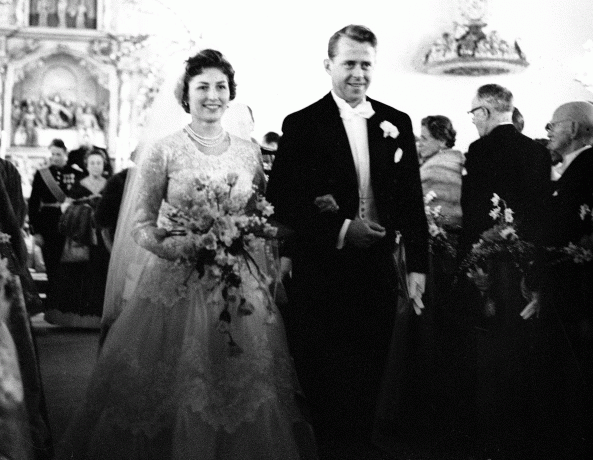
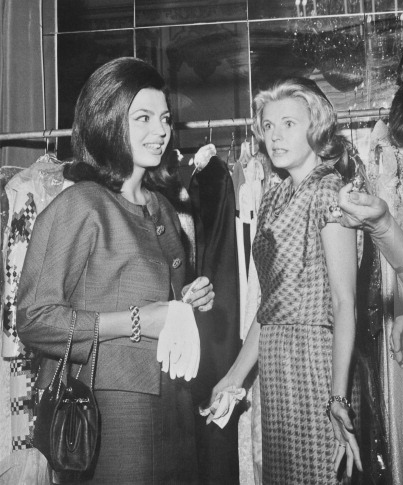
A few weeks later on January 12th, her presence was noted at the royal wedding of Princess Astrid of Norway and Johan Ferner.Princess Astrid's Wedding In early February Peggy announced through the press, that her escort to the wedding, Prince Charles d’Arenberg, a man 27 years her senior, was actually her husband, having secretly married him in Massachusetts on December 29th, which went a long way in explaining magnanimity in regards to Tommy’s December marriage. Now titled Her Serene Highness, Princess d’Arenberg, the princely d’Arenberg residence in Paris was Peggy’s official home. Within months Peggy gave the press more fodder when she and Tommy publically fought in the French courts that summer for custody of Muffie, who had initially been awarded to Peggy, but actually spent most of her time with her father and her maternal grandmother in the States while Peggy was trotting around the globe. Peggy didn’t show up to court, pleading illness and pregnancy. Tommy’s lawyers countered that her presence at the season’s couture shows and fashionable watering spots like Deauville indicated otherwise. Peggy however, was indeed pregnant, and soon gave birth to a son, Prince Frederick d’Arenberg. AS in New York, she quickly became a leader of French society, maintaining her reputation as a fun and irreverent hostess. The New York Times noted her introduction of “the twist” at a party she threw for 70 at Maxim’s during the 1964 season, and her gamely walking the runway for a charity fashion show as a favor to her friend Princess Irene Galitzine (Peggy is pictured backstage below in a candid moment with fellow “celebrity model and good friend Princess Ira von Furstenberg). Though in the thick of the Euro-scene, she returned to New York regularly, usually making a splash with parties thrown in her honor and enlivening the others that she attended. In an effort to dispel the image that she was just a frivolous jet setting princess, she gave an interview to Eugenia Sheppard in the autumn of 1964, in which she pointed out while it was true she that had been to Capri, St Moritz, Salzburg, Deauville, Fiji, Bali, Tahiti, Rio, Tokyo and Palm Beach in the past twelve months, it was not always by jet. Sometimes she took a boat. Life appeared to be a perfect fairy tale for the princess, with a title, wealth, and parties round the world, but all was not as serene for the serene highness as it might seem on the surface In the Autumn of 1966, Peggy filed for divorce after 5 years of marriage. It promised to be a nasty one. Charles countersued, charging Peggy with adultery, claiming she had four lovers. If proven true, it would make her alimony next to nil (something she would sorely need, having spent most of her own fortune). She remained under the same roof as her husband in their Paris residence, claiming they were on friendly terms in spite of his charges against her, but in fact it was court ordered on account of their custody battle over young Prince Frederick. Peggy then let the press know not to expect her in New York that season as she was going to forgo the social whirl to fight for him. She immediately made an exception however, flying over to attend Truman Capote’s famous Black and White Ball that November (and who could blame her?). The case was still unresolved with no end in sight when the Prince, unexpectedly died in June of 1967 at the age of 62. Peggy quickly proclaimed the couple had discretely reconciled and the divorce had been called off shortly before his passing. The d’Arenberg family gave her a generous allowance guaranteed the inheritance rights of her son, and under the proviso she vacate the d’Arenberg residence immediately, which she did. If Peggy’s story of she and her late husbands twilight reconciliation was true, she did not mourn long, soon back on the global party circuit.
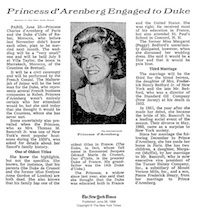
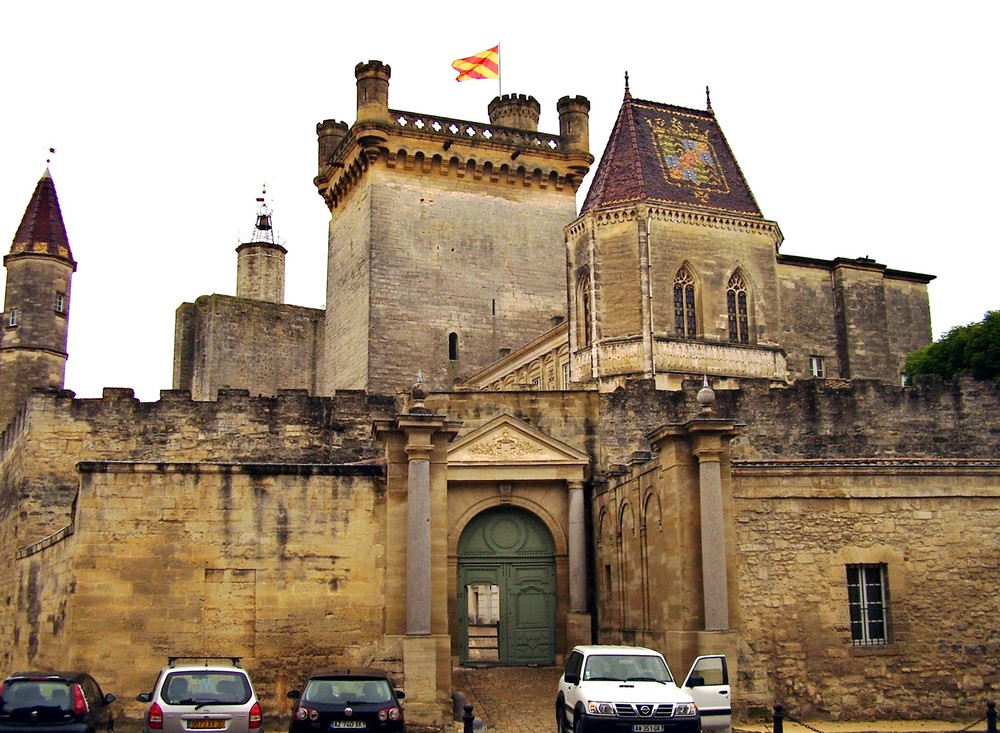
The next year Peggy once again jumped out of the mere social columns and onto the headlines when she announced she would be marrying a French Duke in July of 1968. Her fiancé, Emmanuel de Crussol d’Uzes, was heir to the oldest and premier dukedom in France (in terms of titles, it would be a step up for her serene highness, as in France a duke trumps a prince in noble hierarchy). When interviewed, Peggy couldn’t give many specifics as to his family and its history (other than his parents were dead), where the wedding would take place other than in Morocco, where the Duke worked), or who the attendants would be. The only thing she seemed absolutely certain of was her wedding dress, which was to be a pale blue Dior. She, and the world, learned soon enough. Their July 12th wedding was performed by the Pasha of Marrakech, and witnessed by the Maharajah of Jaipur and la Comtesse de Breteuil. The couple settled (if settled could possibly be an appropriate term for Peggy’s life) in the Duke’s homes in Paris, Rabat, and the town of d’Uzes, where Peggy’s funds (or more accurately her mother’s, on whose largesse Peggy was now dependent) paid to restore the family’s ancestral castle. The couple hardly stayed in any one place for long though, and spent a good amount of time in New York for her daughter Muffie’s debut and marriage in the early 70’s (always with Tommy’s magnanimous presence, perhaps looking at Peggy’s subsequent life, he felt he got of lucky!). The party ended forever for Peggy in 1977 when a car she was passenger in on the way back from a party outside Paris crashed, killing her instantly. She made the international headlines for one last time, with the press recounting her Standard Oil money, elegant sense of style, social triumphs and multiple glamorous marriages, barely hinting at the fact that she and the Duke had been estranged for over a year, and her money was effectively gone. Soon enough, she was all but forgotten by the press, mentioned every now and then in terms of one of her contemporaries like Lily Pulitzer or Sunny von Bulow. Perhaps she had despite a wild ride, she had too much taste, her affairs were too discrete, and her parties too tame by today’s standards. Despite her best attempts at rebelling against the confines of wasp society, she pushed against the boundaries of her class but never crossed the line.



